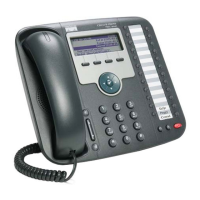1-8
Cisco Unified IP Phone 7931G Administration Guide for Cisco Unified Communications Manager 8.0 (SCCP and SIP)
OL-20798-01
Chapter 1 An Overview of the Cisco Unified IP Phone
IPv6 Support on Cisco Unified IP Phones
Related Topics
• Understanding Interactions with Other Cisco Unified IP Communications Products, page 2-1
• Understanding the Phone Startup Process, page 2-6
• Network Configuration Menu, page 4-6
IPv6 Support on Cisco Unified IP Phones
The Cisco Unified IP Phone uses the internet protocol to provide voice communication over the network.
Previous to Cisco Unified CM 7.1, only the internet protocol version 4 (IPv4) was supported. Because
it uses a 32-bit address, IPv4 cannot meet the increased demands for unique IP addresses for all devices
that can connect to the internet. Internet Protocol version 6 (IPv6) is an updated version of the current
Internet Protocol, IPv4. IPv6 uses a 128-bit address and provides end-to-end security capabilities,
enhanced Quality of Service (QoS), and increased number of available IP addresses.
The Cisco Unified IP Phone supports IPv4 only addressing mode, IPv6 only addressing mode, as well
as an IPv4/IPv6 dual stack addressing mode. In IPv4, you can enter each octet of the IP address on the
phone in dotted decimal notation; for example, 192.240.22.5. In IPv6, you can enter each octet of the
IP address in hexadecimal notation with each octet separated by a colon; for example,
2005:db8:0:1:ef8:9876:ba72:dc9a. The phone truncates and removes leading zeros when it displays the
IPv6 address.
Cisco Unified IP Phones support both IPv4 and an IPv6 address transparently, so users can handle all
calls on the phone to which they are accustomed. Cisco Unified IP Phones support the use of IPv6 only
with Cisco Unified CM 7.1 and only with the Skinny Call Control Protocol (SCCP).
Cisco Unified IP Phones do not support URLs with IPv6 addresses in the URL. This affects all IP Phone
Service URLs, including services, directories, messages, help, and any restricted web services that
require the phone to use the HTTP protocol to validate the credentials with the Authentication URL. If
you configure Cisco Unified IP Phone services for Cisco Unified IP Phones, you must configure the
phone and the servers that support the phone service with IPv4 addresses.
If you configure IPv6 Only as the IP Addressing Mode for phones that are running SIP, the Cisco TFTP
service overrides the IP Addressing Mode configuration and uses IPv4 Only in the configuration file.
Trivial File Transfer Protocol
(TFTP)
TFTP allows you to transfer files over the
network.
On the Cisco Unified IP Phone, TFTP enables
you to obtain a configuration file specific to the
phone type.
TFTP requires a TFTP server in your
network, which can be automatically
identified from the DHCP server. If you
want a phone to use a TFTP server other
than the one specified by the DHCP server,
you must manually assign TFTP server
from the Network Configuration menu on
the phone.
For more information, see the Cisco Unified
Communications Manager System Guide,
Cisco TFTP.
User Datagram Protocol
(UDP)
UDP is a connectionless messaging protocol for
delivery of data packets.
Cisco Unified IP Phones transmit and
receive RTP streams, which utilize UDP.
Table 1-2 Supported Networking Protocols on the Cisco Unified IP Phone (continued)
Networking Protocol Purpose Usage Notes

